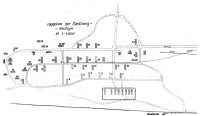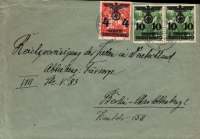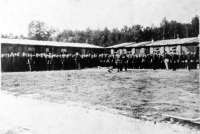 |
| Camp Map |
Budzyn is a village in the
Lublin district, situated 5 km (3 miles) northwest
of the town of
Krasnik. A military – industrial complex, including an
aircraft factory, was established on the premises of a former munitions factory in
1937-38.
Following the German occupation of Poland, the military industries were taken
over by the
Hermann Göring Werke, an organisation formed in the early days
of the Nazi regime by
Göring and some of his cohorts as a
Reich-owned enterprise.
Hermann Göring Werke was to become a gigantic concern, operating steel works,
mines and other heavy industries throughout occupied Europe. The aircraft factory
was operated by the
Heinkel Company (Heinkel Flugzeugwerke).
A forced labour camp was set up in Budzyn in the
autumn of 1942, and 500 Jews were
brought in from neighbouring towns at the beginning of
November 1942, mainly from
Krasnik. At that time the local ghetto was liquidated in that town, and the
prisoners destined for the Budzyn camp were selected from among several thousands
of Jews who were to be deported to
Belzec or shot at the
Krasnik Jewish cemetery. That autumn a further 400 POWs were added
from the
Konskowola camp and from the
Lipowa Street Camp in
Lublin. From
inception, Jewish POWs formed the functionary prisoners in the camp; they still wore the uniform of the Polish army.
 |
| Letter from Belzyce |
At the
beginning of 1943, the last Jews from the
Belzyce ghetto, including women and children, were also sent to Budzyn.
Among this group were German Jews deported to
Belzyce
from
Stettin in
1940 and from
Leipzig in
1942.
Following the suppression of the
Warsaw Ghetto Uprising, 800 Jews arrived from
Warsaw at the
end of April and the
beginning of May 1943. The
Warsaw group consisted of about 150 Jewish workers who had worked at the
Okecie Airfield in
Warsaw prior
to the uprising in the ghetto.
The final group of prisoners were sent to the camp on
10 July 1943. These
were the last Jews from the
Hrubieszow Ghetto.
By
mid 1943 the
camp population had risen to 3,000, including 300 women and children. The precise
number of Jewish prisoners in Budzyn was provided in the report by the Home
Army (AK – Armia Krajowa) from
Krasnik, dated
15 March 1944.
At that time there were 2,457 Jews in the camp, including 319 women.
This number of prisoners was lower than in
1943 as a result of executions and
selections in the camp. The prisoners worked in the military factories, in
construction and in general services.
The first commandant of Budzyn was
SS-Unterscharführer
Otto Hantke, succeeded by
SS-Oberscharführer
Heinrich Stoschek. Before taking up his position in
Budzyn,
Hantke had served as an SS man in
the
Lipowa Camp in
Lublin. He was sent to
Krasnik personally by
Odilo Globocnik as "a good organiser”.
Hantke was responsible for the
selection during the final liquidation of the
Krasnik Ghetto. He
personally selected the first prisoners when they arrived at the camp. He was also
responsible for the first selection of the sick prisoners, who were deported to
Belzec. This selection was organised in accordance with an order from
Christian Wirth. The next, and most notorious
commandant of the camp was
SS-Oberscharführer Reinhold Feix
(
December 1942 – August 1943), who was replaced in turn by
Otto Mohr.
Mohr’s reign was short lived; he was replaced
in the
late summer of 1943 by SS NCO
Fritz Tauscher.
In the meantime the function of the commandant was also in the hands of
Adolf Axmann.
Tauscher
was replaced by a man named
Frank. Whilst he
was not in command for very long,
Frank
ruthlessly suppressed a mass escape attempt in the
winter of 1943. The final commandant
was
SS-Obersturmführer Josef Leipold.
In
February 1944, Budzyn officially became a sub camp of
KZ Majdanek. The SS garrison
numbered 74 persons, all of whom, including
Leipold,
had previously served at
Majdanek.
Leipold
went on to command the
Schindler camp at
Brünnlitz,
at the end of the war, having shot himself in the foot, injuring his right toe. The
rumour amongst the camp inmates was that he had deliberately carried out this
act to avoid front-line service
Feix and
Tauscher
both served at
Belzec.
Feix
was one of the cruellest and most brutal SS men at
Belzec, and he
continued in the same manner in Budzyn. Neither those who preceded or succeeded
him as commandant were as barbaric.
In
March 1943 he participated in the final
liquidation of the
Belzyce ghetto, during which "action" many children and
women were killed before the eyes of the other Jews and Poles of the town.
The Ukrainians of the camp guard together with
Feix
himself, beheaded the victims with axes. Selected Jews had to observe these
executions and were later sent to Budzyn.
Feix
also organised public mass executions in the camp. The selected prisoners, who
were accused of all kinds of misdemeanours, were shot or hanged during the
evening roll calls, either on the
Appellplatz or just behind the fence of the camp.
Sometimes the bodies of the victims were cremated in this place. After every
execution the prisoners had to sing, especially the Polish tango "Marianna" or
Yiddish songs.
Feix had a mascot in
the camp, a 6-7 year-old Jewish boy called
"Malpe" ("Ape") or
"Borscht" by the
inmates. The boy wore an SS uniform and held a small whip whilst assisting the
commandant. The execution of
Rudolf Bauchwitz,
a German Jew from
Stettin who was a member of the group of Jews from
Belzyce ghetto, was a notorious event.
Bauchwitz
had been a lieutenant in the German army during WW1, and was a
very popular person in the camp. Because he was a fluent German speaker, he
worked in the camp administration. He was well liked by the other prisoners as well
as by some of the SS men, who saw in him a representative of German culture and
discipline.
Bauchwitz's wife and son were
also prisoners in Budzyn. One day
Feix ordered
Bauchwitz to be publicly hanged. Nobody
knew the reason for this execution, but among the prisoners there were rumours
that
Bauchwitz knew too much, and that
Feix hated him because
Bauchwitz did not conform to the Nazi stereotype
concerning Jews.
 |
| Budzyn Camp |
At the trial of
Adolf Eichmann,
a survivor of Budzyn, Dr
David Wdowinski,
described how he had been deported to
KZ Majdanek in
May 1943
following his participation in the
Warsaw Ghetto Uprising. A few
days later he was transferred to Budzyn together with 806 other Jews.
He described their reception at the camp:
"
Turning, we sighted Camp Budzyn about a quarter-mile distant, this was
a genuine SS camp, a fenced in rectangle flanked by four towers, one at
each corner. Looking out from the top of these were armed Ukrainian
guards manning machine guns. Directly ahead was the entrance gate.
A guardhouse on our right, across the road from a cluster of young pines
and brush, was the last landmark as we stood outside the gates. Beyond the barbed wire
stood a row of barracks backed by a large open square. No bigger than a football
field, the complex was surrounded by a belt of open country surrounded by pinewoods…
The commandant Feix told us to stand
in two rows. Afterwards, he went up to one of the Jews and told him to leave the
rank and ordered him to undress. He then began undressing; he removed
his overcoat and Feix started
shouting: "Hurry up - undress completely!" This went on until he was altogether
naked, and then he drew a revolver and killed this Jew and said: "This is
what will happen to each one of you if you do not hand over everything you
have, and this is only an example." He demanded gold, silver, good
clothes, suitcases, and so on ...
On the same day, he saw a man of advanced age, an old man, and
his first words were: "You old dog - are you still alive?" And he ordered the
Ukrainians to shoot him and kill him - and he went off. Then we surrounded
the old man, and the Ukrainians were unable to find him. By chance, the
commandant came back to the camp half an hour or an hour later and saw the
old man - he drew his revolver and shot him. He was a very popular doctor from
Warsaw, very much loved by the Jews of
Warsaw - Dr Pupko.
He was well known, firstly because he was an Orthodox Jew: he prayed every
day with his phylacteries and prayer shawl; he would not write any prescriptions
on the Sabbath, and, apart from that, he was known and loved, for he had
done a great deal as a doctor for the poor Jews and had attended to them
without payment."
Wdowinski related another incident
involving a prisoner named
Bitter, who had
been discovered with money on his person.
Feix
had beaten him and then commanded that
Bitter
should be hanged. But the rope broke.
Feiks,
deciding it was not necessary to hang
Bitter
again and not wishing to waste a bullet on a Jew, ordered that his fellow Jews
would kill
Bitter. A roll call was ordered.
Each of 2,000 Jews was given a stick and forced to beat
Bitter to death.
In the
autumn of 1942, approximately 100 sick or elderly persons and children
were sent to
Belzec. In
August 1943,
a further 200 prisoners
classified as sick and unfit for work were transported to
Majdanek
for extermination. Many prisoners died in the camp itself due to the inhuman
conditions; hunger, disease, and maltreatment.
A decree, issued by
Oswald Pohl
on
2 September 1943, announced that with effect from
1 November, the
Lublin labour camps would be subordinated to the Ministry of Munitions and
Armaments. In order to prevent this from happening, and thereby losing
control of these valuable resources, the SS declared that the labour camps
were branches of
Majdanek. Eventually, Budzyn was declared a concentration
camp and made a sub-camp of
Majdanek on
13 February 1944.
By that time, all of the other work camps in the
Lublin region had
been liquidated in the
Aktion Erntefest in
November 1943. Only the
workers at the
Heinkel factory at Budzyn were spared from this massacre because of the
continuing importance of aircraft production, but even there, most elderly people
had been selected and taken to
Majdanek for execution. One of the
Jewish cleaners in the camp,
Jacob Katz,
saved the lives of seven elderly Jews at this time by hiding them under mattresses.
After Budzyn was subordinated to
Majdanek, the conditions
of life in the camp improved. All prisoners were removed from the old camp to
the new barracks closer to the factory. They had to wear prisoner clothing from
Majdanek and they received numbers. All executions, which were fewer
in number in
1944, had to be conducted in accordance with concentration
camp regulations. Even the food was better then before.
Although bad enough, conditions at Budzyn became relatively bearable in
comparison to other labour camps, largely due to the efforts of
Noah Stockman of
Brest-Litovsk,
the camp elder, who even managed to persuade the camp administration to
allow Passover to be celebrated in the camp in
spring 1944.
In
May 1944, as the
Red Army began to approach the
Lublin District, the factory
installations and some of the workforce were transferred to the
salt mine in Wieliczka. Other prisoners were dispersed to camps at
Skarzysko-Kamienna, Starachowice, Mielec and
Ostrowiec, as well as to
Majdanek itself. Included
among those transferred to
Mielec was
Manfred Heyman,
born in
Stettin and deported from there to the
Belzyce Ghetto in
February 1940. He had
been sent to Budzyn at the age of 14.
Transferred yet again to another aircraft factory near
KZ Flossenbürg,
he survived a death march from that camp and was liberated by American troops on
29 April 1945.
Trial:
Hamburg, 1974
Hantke, Otto - Life imprisonment
Mic., Georg - 12 years
Polizei SSPF Lublin, Haftstättenpersonal ZAL Budzyn
Deportation of at least 300,000 Jews to KL Treblinka and shooting of several thousand Jews in course of the
liquidation of the Warsaw Ghetto. Deportation of at least 15,000 Jews to KL Treblinka and Auschwitz
as well as forced labour camps in the Lublin District in course of the liquidation of the Bialystok Ghetto.
Killing of Jewish forced labourers at ZAL Budzyn and Krasnik.
Sources:
Gutman, Israel, ed.
Encyclopedia of the Holocaust, Macmillan Publishing Company, New York, 1990
Hilberg, Raul.
The Destruction of the European Jews, Yale University Press, New Haven, 2003
Gilbert, Martin.
The Holocaust – The Jewish Tragedy, William Collins Sons & Co. Limited, London, 1986
Gilbert, Martin.
The Boys – Triumph Over Adversity, Weidenfeld & Nicolson, London, 1996
Marszalek, Josef.
Majdanek – The Concentration Camp in Lublin, Interpress, Warsaw 1986
Marszalek, Jozef.
Obozy pracy w Generalnym Gubernatorstwie w latach 1939-1945 (The
Work Camps in Generalgouvernement in the years 1939-1945). Lublin 1998.
Topas, George.
Iron Furnace – A Holocaust Survivor's Story, The University Press of Kentucky, 1990
Wyszogrod, Morris.
A Brush with Death. An Artist in the Death Camps. New York 1999
Orenstein, Harry.
I Shall Live. Surviving the Holocaust 1939-1945. Oxford University Press 1988
Archive of the Majdanek State Museum, Collection of the Jewish testimonies.
www.clab.com.pl./regionalista/budzyn.htm
www.nizkor.org/hweb/people/eichmann-adolf/transcripts/sessions/session-067-05.html
© ARC 2005










